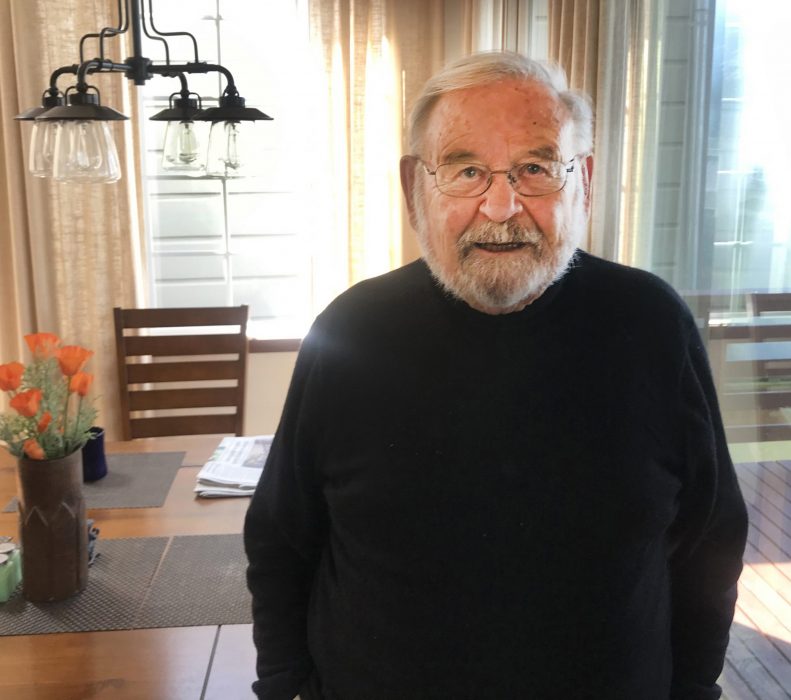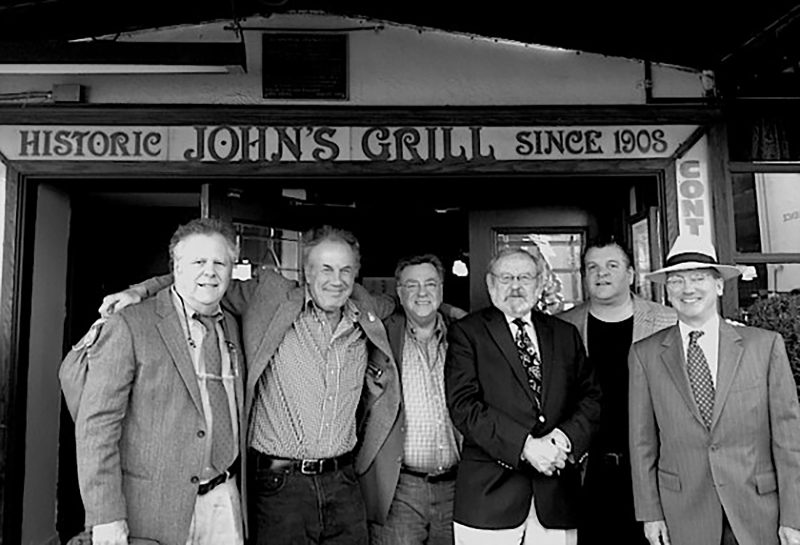Never did one writer have so much fun: Carl Nolte’s career put him up close and personal with the good, the bad and the ugly
Journalism, these days, is a young person’s game. As newspapers fold or reduce their staffs, veteran reporters, editors and photographers are laid off, pushed into early retirement, or simply give up on the business they love. But not Carl Nolte.
At 88, the San Francisco Chronicle columnist is likely the oldest working journalist in the Bay Area, maybe Northern California. He still hits his deadlines, turning out a weekly column – Native Son – that runs on page two of the Sunday paper. And while you might guess that Nolte, a fourth-generation San Franciscan, would use his perch to bemoan the changes that have transformed his city, you’d be wrong “Change, he says, “is it.”

Whatever San Francisco’s faults, and Nolte is not one to ignore them, he loves his city.
After taking a long walk around town in early September, he wrote: “In a couple of hours over a single day, you can see the city in its complexities, shifting, changing, like a kaleidoscope. You have to admit: For all its faults, San Francisco is beautiful to see.”
Nolte joined the Chronicle in 1961. He’s been a reporter and editor. He still remembers his first day on the job: June 18, 1961. He was assigned to the paper’s copy desk, where men – there were few women in newsrooms then – in white shirts smoked cigarettes and marked up copy with pencils. “It was hot; there was no air conditioning and I was sweating.” Not just because the newsroom was so warm. “I didn’t really know what the hell I was doing. When I got hired, I got a book out of the library about how to be a newspaper editor.”
‘All in a day’s work’
Whatever the book counseled, it must have worked. Nolte has written and edited thousands of stories. How many, he can’t even estimate. Many of his bylines are trapped in envelopes, relics of those pre-digital days when librarians tore out stories from the paper every day and filed them away. Others are somehow buried and hard to find in Google’s digital ocean.
When asked why he’s stayed at the paper so long, Nolte jokes: “Lack of ambition.” But that’s hardly the case. He’s stayed at the Chronicle because he’s had so much fun.
“I’ve covered baseball in Toronto, Boston, Cleveland and covered political campaign. You could go places, do stuff,” he said during a recent interview. He sailed across the Atlantic on the Jeremiah O’Brien, the last remaining Liberty Ship, and drove around the desert in Saudi Arabia, searching for a secret military base while covering the first Gulf War. Fires, murders, a crisis at the opera, kidnappings – don’t forget Patty Hearst and Jonestown – not to mention San Francisco’s rich history of civic corruption. All in a day’s work.

Long before the Internet made stars of a new generation of young journalists, working at the Chronicle gave high-profile writers like Nolte status and the opportunity to eat and drink with the city’s political and social elite. They’d gather at spots like the Washbag, the insiders’ nickname for the long-vanished Washington Square Bar and Grill in North Beach. “You’d go there and drink white wine spritzers. You’d have to fight your way to the bar and sometimes you’d see (former mayors) Feinstein and Moscone there and Ed Moose (the legendary owner) would know your name.”
‘Act like you belong’
That was in the ‘70s, a period Nolte called the “golden age of the Chronicle.” On further reflection, he amended that comment, saying, “It was the golden age of us.”
Known as a graceful writer with a relaxed, conversational prose style, Nolte seeks out people and places that don’t always make the papers. He’s more likely to write about a harbor pilot or firefighter than a politician or the technorati. Beyond the occasional reference to his wife, who he calls the Sailor Girl, he almost never writes about his family. Nolte has three grandchildren, who he jokingly calls “my associates.”

 Nolte and his wife, Darlene Plumtree, at the Old US Mint. (Photo courtesy of the Bernal Heights History Project.)
Nolte and his wife, Darlene Plumtree, at the Old US Mint. (Photo courtesy of the Bernal Heights History Project.)One secret to his success: “Stand around and look important.” By that, he doesn’t mean be overbearing. Act like you belong is more like it.
He was once mistaken for a ship’s officer in California, which allowed him to go whale watching on a boat where a reporter wasn’t welcome. While in Kuwait, a soldier called, “Hey Carl.” But a guard thought he had heard “Hey, Colonel.” While sailing on the Jeremiah O’Brien he learned how to steer the ship. He did so well he was asked to pilot the historic vessel through the Panama Canal. But that was a bit much, even for Nolte, and he demurred.
A nose for the streets
Nolte is something of an expert on San Francisco history and the streets of his neighborhood. He and his wife live on Winfield Street in Bernal Heights. The steep street was originally called Chapultepec, a decisive battle of the Mexican American War, he said. Now it’s named after Winfield Scott, a hero of that battle who was later known as Old Fuss and Feathers. Lundy’s Lane? Named after a battle in the war of 1812. And Eugenia Street, he said, was named after the daughter of a man who managed a nearby toll road.
It’s no accident that Nolte’s column is called Native Son. He a fourth-generation San Franciscan who grew up on Potrero Hill, then a working-class outpost overlooking the shipyards, where many of the residents worked. He got his first newspaper job when he was 11, delivering copies of the old San Francisco News.
Nolte’s father was a night watchman. At one point, the family couldn’t pay the rent and after being evicted, stayed in a cabin with no electricity for six months. In those days, even relatively poor people could afford a home in the neighborhood. His family bought a small house for $2,250. It’s now valued at about $1.628 million, according to a real estate site Nolte accessed handily with his iPhone.
After graduating from St. Peter’s, a Catholic High School on the edge of the Mission District, Nolte attended City College of San Francisco and the University of San Francisco. He worked for the university’s communications department until he was hired by the Chronicle. He taught journalism part-time at San Francisco State College for years, and often shared stories over drinks with students at a bar in the Sunset.
A journalist’s journalist
Kevin Fagan, a longtime Chronicle reporter, has worked with Nolte for decades. Like many Bay Area journalists, he regards Nolte as a friend and a mentor. “Carl has been an absolute role model for me and has been since before I got to the Chronicle,” he said. “He writes with a command that’s difficult to define that comes from decades of experience.”
Nolte has received numerous professional awards, many related to his writings on local history and the maritime industry. In 2007, the Book Club of California presented him the Oscar Lewis Award for writing that contributed to western history. Robert Rosenthal, then the Chronicle’s managing editor, said at the time that Nolte’s prose “resonates with his voice, his knowledge and his unique ability to weave stories that pull readers along as they delight and inform.”
Nolte works part-time these days and says he doesn’t miss going to the office every day. But he still loves his work. Asked if he’s thinking about retiring, he said simply: “I’ve thought about it. Right now, I plan to keep on until they tell me to stop.”






Marilyn N Herand
Great article. I admire Carl Nolte and always look forward to his columns. I so enjoyed this interesting story about him.